
IMPROVING CAMPUS INFRASTRUCTURE
Some of the major improvements to infrastructure completed over the summer are very visible; others are not. Read in this issue about the many major projects completed by Physical Facilities and Information Technology Services, as well as the new programs offered by the University Center for Training and Development.

SCHOOL OF PHARMACY AND PHARMACEUTICAL SCIENCES OPENS NEW BUILDING
The opening of the new, $60-million School of Pharmacy and Pharmaceutical Sciences at the University's Health Sciences Campus in Johnson City, N.Y., headlines this quarterly report, but there's also good news about collaborations, external funding and student successes. Read more in this issue.
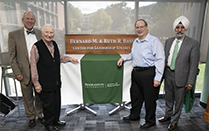
SUCCESSFUL INITIATIVES SUPPORT STUDENTS
It takes donors at many levels to make Binghamton University successful, and in this issue of the quarterly report, you can read about a number of them. Whether it's AVANGRID offering full-tuition scholarships and capstone project support, or playing golf to benefit the Alumni Legacy Scholarship, the Division of Advancement works with Binghamton supporters.
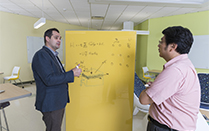
BINGHAMTON RESEARCH FUNDING SETS RECORD
Binghamton University reported research expenditures totaling $47.5 million in 2017-18, an increase of about 19 percent from the previous fiscal year. The figure tops 2011-12, the campus’ all-time best year for research funding, when just over $40 million was reported. The new record, which follows several years of steady growth, is an important sign of the campus’ creativity and innovation. Healthcare research accounted for nearly a third of expenditures, with electronics packaging and systems engineering following at about 22 percent.
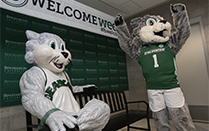
BAXTER THE BEARCAT BOOSTS SCHOOL SPIRIT
The Division of Student Affairs spent the summer hosting students and families for orientation and preparing for the opening of the fall semester. With some new people on board and some others with new duties, it has been a busy time. Not too busy, though, to show Binghamton University pride, as you'll read about the new Baxter the Bearcat Bench in the University Union in this issue.
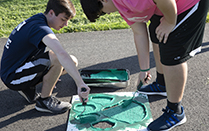
STUDENT-ATHLETES CONTINUE TO SUCCEED ACADEMICALLY
Student-athletes continue to shine on and off the courts and fields. The Athletics Department sets high academic standards, and student-athletes surpass them across the board. Read about the accomplishments made by student-athletes in their sports and in the classroom – and check out the videos showcasing fall sports and the new women's head basketball coach, Bethann Shapiro Ord, in this issue.
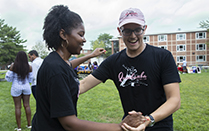
HELPING TO MAKE THE CAMPUS MORE INCLUSIVE
The Division of Diversity, Equity and Inclusion works to educate and empower everyone on campus in ways that create a welcoming community. From the Udiversity Educational Institute, that holds trainings for students, faculty and staff, to the Multicultural Resource Center and Q Center, the division's offices that work to build bridges and support students though education and events such as Sundaze, part of its Welcome Week programming. Read about the division's recent initiatives in this report.
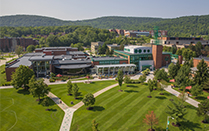
DONOR SUPPORT ADVANCES BINGHAMTON UNIVERSITY
The Binghamton University Foundation had a successful 2017-18 year, bringing in the second highest amount of cash ever in support of the University. Read the numbers in this issue of the quarterly report, and learn one way the Foundation celebrates its donors.
University unveils Lindsay Study Room
Binghamton University paid tribute to one of its greatest scholars when the Kenneth C. Lindsay Study Room officially opened in the University Art Museum on Oct. 11.
“This is a room in which we will be able to renew the kind of art-history teaching that Ken believed in so much,” said John Tagg, professor of art history and comparative literature. “It is teaching that begins with the encounter between the student and the object or the artifact.”
Lindsay arrived at Harpur College in 1951 and would go on to chair the Art History Department for 17 years. He retired from the University in 1989 and received the University Medal in 2007 for his contributions as a Monuments Man during World War II, in which he helped to save European art treasures that had been seized by the Nazis. Lindsay died in 2008 at age 89.
“What delights me, too, is that by teaching in this room, we are going to be able to remember one of the key founders of this institution – one of the people of who came here when this was nothing but a field,” Tagg said. “He is one of those people who built not just the fabric of Harpur College, but also its ethos.”
The Homecoming celebration featured remarks from Tagg; Provost Donald Nieman; Harpur College Dean Anne McCall; and University Art Museum Director Diane Butler. About two dozen people, including Lindsay’s wife Christine, attended the celebration, which also featured a lecture from one of Lindsay’s protégés: William Voelkle ’61, curator and department head of medieval and renaissance manuscripts at the J.P. Morgan Library and Museum in New York.
The study room, located at the rear of the first floor of the Art Museum, offers a long table where up to 20 students can study or observe prints, photographs or art pieces. Tagg and Butler have already installed several objects in the room, which also features two custom-made print rails.
Nieman, who previously served as dean of Harpur College, said it has been a longtime goal to develop a stronger relationship between the Art Museum and the Art History Department. A study room, he said, is perfect for “faculty to use objects from the museum’s collection to teach classes.”